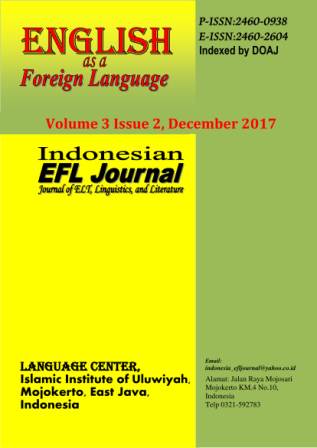Communication Strategies used by EFL Students in Their Presentation
Abstract
In the process of communication using the target language, EFL students usually have some problems to communicate their ideas. To cope with the problems they encounter, the students will try to use certain communication strategies so that their ideas can be clearly explained. This paper reports the results of the research on the communication strategies used by EFL students in their presentation. This study is designed as a qualitative research. The subjects of the study were the seventh semester students representing more and less proficient students in their classes. The data are the communication strategies employed by the students when they had oral presentation for Cross Cultural Understanding course. The results of the research reveal that the more proficient students used eleven types of communication strategies and the less proficient students used thirteen types of communication strategies. Some interlingual strategies, code switching, appeal for help, and some non linguistic strategies were used by the students. It is also found that the more proficient students used more L2 based strategies, and L1 terms occurred in the language of all levels of proficiency. Despite the differences, the students need to be encouraged to use more compensatory strategies to achieve their communication goal.
References
Bialystok, Ellen. (1990). Communication Strategy: A Psychological Analysis of Second-Language Use. London: Basil Blackwell Ltd.
Bogdan, R.C. and Biklen, S.K. (1982). Qualitative Research for Education: An Introduction to Theory and Methods. Boston: Allyn and Bacon.
Brown, Douglas. (2007). Principles of Language Learning and Teaching (Fifth Edition). New York. Addison Wesley Longman Inc.
Celce – Murcia, Mariane. (2001). Teaching English a a Second or Foreign Language. Boston.: Heinle & Heinle.
Corder, S. P. (1983). Strategies of communication. In C. Faerch, & G. Kasper, (Eds.), Strategies in interlanguage communication. New York: Longman.
Dornyei, Z. (1995). On the teachability of communication strategies. TESOL Quarterly, 29(1): 55-84. doi:10.2307/3587805
Ellis, Rod. (2008). The Study of Second Language Acquisition (Second Edition). Oxford. Oxford University Press.
Faerch, Clause and Kasper, Gabriele. (1983). Strategies in Interlanguage Communication. New York. Longman.
Huang, Chiu-Ping. (2010). Exploring Factors Affecting the Use of Oral Communication Strategies. In http://www.lhu.edu.tw/ accessed January 2012.
Lazaraton, A. (2002). A Qualitative Approach to the Validation of Oral Language Tests. Studies in Language Testing 14. Cambridge: UCLES/Cambridge University Press.
Malasit,Y. And Sarobol, N. (2009). Communication Strategies Used by Thai EFL Learners. Thailand: Thammasat University.
Savignon, S.J. (1983). Communicative Competence: Theory and Practice. Reading, MA: Addison-Wesley
Scarcella, R. C., & Oxford, R. L. (1992). The tapestry of language learning: The individual in the communicative classroom. Boston, MA: Heinle & Heinle.
Selinker, L. (1972). Interlanguage. International Review of Applied Linguistics, 10(3): 209-231.
Tarone, E. (1980). Communication strategies, foreigner talk, and repair in interlanguage. Language Learning, 30(2): 417-431.
Tiono, Nani I, Sylvia, Agatha. (2004). The Types of Communication Strategies Used by Speaking Class Students with Different Communication Apprehension Levels in English Department of Petra Christian University, Surabaya.6(1), 30-46
Ya-Ni, Zhang. 2007. Communication Strategies and Foreign Language Learning. In www.linguist.org accessed January 2012.
Copyright (c) 2017 Indonesian EFL Journal: Journal of ELT, Linguistics, and Literature

This work is licensed under a Creative Commons Attribution-ShareAlike 4.0 International License.
All rights reserved.
this publication may be reproduced, stored in a retrieval system, or transmitted
in any form or by any means, electronic, mechanical, photocopying, recording.




